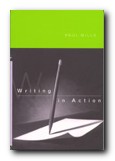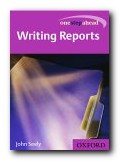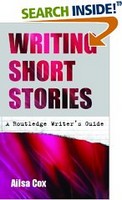a selection of resources reviewed
Writing for newspapers is probably the hardest form of journalism to break into. That’s because newspapers have traditionally been run by ‘closed shop’ unions. They are now also threatened by falling sales as digital publishing grows. But that means they will be forced to rely on freelance writers as they shed staff. These guides will give you invaluable advice on how to deal with editors and newsrooms.
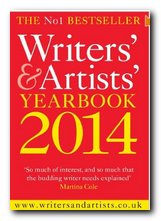 The Writers’ and Artists’ Year Book
The Writers’ and Artists’ Year Book
It doesn’t matter which branch of journalism, creative writing, or media publishing you wish to pursue, before you have gone very far you will need this book. It’s a compendium of full contact details for agents, agencies, editiorial offices, and publishers in all fields. Book and magazine publishers, newspapers, theatrical agents, picture agencies, and publicists. Plus there are essays written by professional writers on everything from selling your manuscripts to dealing with tax problems when you win the Booker Prize. It’s updated every year.
Buy the book from Amazon UK
Buy the book from Amazon US
Freelance Writing for Newspapers
This deals with the importance of marketing and knowing your readers, first contact with editors, how to write regular columns and features, reviewing, interviewing and meeting deadlines – and how to acquire an inexhaustible flow of ideas. There is information on the essential business of writing including rights (and wrongs), tax, plagiarism, keeping records, rates of pay (and how to get paid), syndication, the power of the press, official organizations to help you, and more. Detailed chapters cover style, research, making the Internet work for you and the rewards of rewriting.
Buy the book from Amazon UK
Buy the book from Amazon US
The Freelance Writer’s Handbook
It’s the subtitle which makes this book so popular – How to Make Money and Enjoy your Life. Now in a fully updated third edition, this is the essential book for everyone who dreams of making money from their writing. It will appeal to all aspiring writers, whether they want to write as a full time profession, or simply to supplement their existing income through writing. This inspiring guide will also benefit professional writers and journalists who want ideas on how to find new markets for their work.
Buy the book from Amazon UK
Buy the book from Amazon US
The Elements of Journalism
This sets out the fundamental questions that all journalists face as they compile their stories. Is journalism’s first obligation the truth? How should journalists exercise their personal conscience? Must its practitioners maintain their independence from those they cover? This is looking at the basic principles of journalism, rather than ‘how to do it’ or how to get published.
Buy the book from Amazon UK
Buy the book from Amazon US
Print Journalism
This is a collection of essays by former journalists all now teaching in universities. They cover all aspects of newspapers, magazines, and journals: who owns them; how they work; and how to write for them. Would-be journalists are given a detailed breakdown of news features, and more importantly how to successfully pitch your ideas to editors, then how to write them if and when they are accepted. Also included is a detailed look at reporting, how news is gathered, the role of editors, and how to make your own writing as a freelancer more likely to be successful. This covers its subject from A to Z.
Buy the book from Amazon UK
Buy the book from Amazon US
Essential English for Journalists, Editors, and Writers
Written by former Sunday Times editor Harold Evans, this is an excellent guide to improving the efficiency of your writing by what he calls ‘a process of editorial selection, text editing, and presentation’. He describes the various responsibilities for writing in the newsroom, but then settles down to his main subject – the crafting of good prose – where he is quite clearly at home. There’s plenty of good advice on sentence construction, editing for clarity, choice of vocabulary, avoiding obscurity and abstraction, plus eliminating vagueness and cliche. It’s a book packed with practical examples, written by a very experienced professional.
Buy the book from Amazon UK
Buy the book from Amazon US
How to Write Articles for Newspapers and Magazines
This contains ten chapters dealing with getting started (generating ideas & focusing on the subject), gathering information (fact vs. opinion, observation, interview), writing the
effective article lead, and a sample query letter when suggesting an article to a publisher. This little book really is focused on how to get published.
Buy the book from Amazon UK
Buy the book from Amazon US
The Complete Idiot’s Guide to Publishing Magazine Articles
This offers advice to aspiring journalists on how to write effective feature articles, and explains how to sell the articles to newspapers, magazines, and trade publications. Suitable for beginners, it explains how to survive as a freelance writer. Take the mystery out of selling your ideas to magazine, newspapers, and web sites by reading this book. It explains who hires writers, what editors want from freelancers, how much you can expect to be paid, how you can write effective query and pitch letters, and how the Internet can help your writing career take off.
Buy the book from Amazon UK
Buy the book from Amazon US
Writing Feature Articles: A Practical Guide to Methods and Markets
This shows you how to write articles for a wide variety of newspapers and magazines, and examines the different techniques required. It analyses a variety of published articles to show what makes them succeed for their audiences. The book provides information on: formulating and developing ideas; studying the markets and shaping ideas to fit them; and researching then organizing your material.
Buy the book from Amazon UK
Buy the book from Amazon US
© Roy Johnson 2009
More on journalism
More on creative writing
More on writing skills
More on publishing
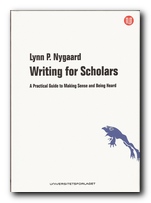
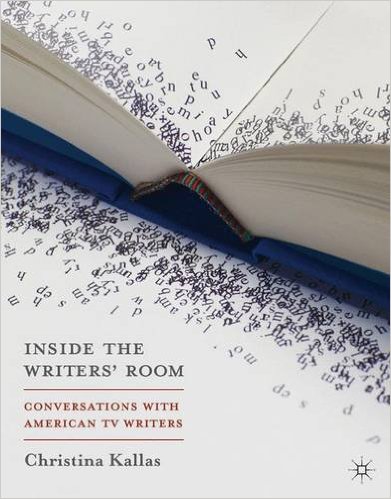

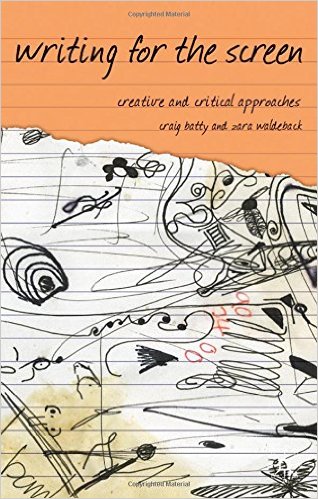
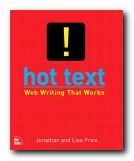 Hot Text: Web Writing that Works
Hot Text: Web Writing that Works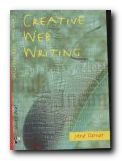 Creative Web Writing
Creative Web Writing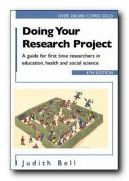 Doing Your Research Project: A Guide for First-Time Researchers in Education and Social Science is a best-selling UK guide which covers planning and record-keeping, interviewing, reviewing ‘the literature’, questionnaires, and writing the final report. Even if you are studying a subject other than education or social science, this is a wonderfully helpful guide on organising your ideas and your writing at research level. It’s a model of clarity and good sense. Now in its third edition – and deservedly so. Highly recommended.
Doing Your Research Project: A Guide for First-Time Researchers in Education and Social Science is a best-selling UK guide which covers planning and record-keeping, interviewing, reviewing ‘the literature’, questionnaires, and writing the final report. Even if you are studying a subject other than education or social science, this is a wonderfully helpful guide on organising your ideas and your writing at research level. It’s a model of clarity and good sense. Now in its third edition – and deservedly so. Highly recommended.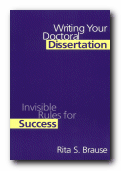 Writing your Doctoral Dissertation: Invisible Rules for Success is a US guide to writing at post-graduate level which uses practical examples, is strong on planning, and offers advice on negotiating the process of research – from making an application to submitting a dissertation. It’s also good on the issue of selecting a research topic and developing it into a feasible project. One of the features which has made this a popular choice is that it offers tips from former students on the problems they have faced in doing research – and how they have overcome them.
Writing your Doctoral Dissertation: Invisible Rules for Success is a US guide to writing at post-graduate level which uses practical examples, is strong on planning, and offers advice on negotiating the process of research – from making an application to submitting a dissertation. It’s also good on the issue of selecting a research topic and developing it into a feasible project. One of the features which has made this a popular choice is that it offers tips from former students on the problems they have faced in doing research – and how they have overcome them.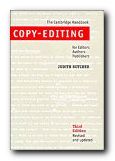 If you have any serious intention of preparing text for publication, then Copy-Editing: The Cambridge Handbook for Editors, Authors and Publishers is your encyclopedia on typography, style, and presentation. It has become the classic UK guide and major source of reference for all aspects of editing and text-presentation, covering every possible bibliographic detail. It also covers a wide range of subjects – from languages to mathematics and music – as well as offering tips on copyright and preparing text for electronic publication.
If you have any serious intention of preparing text for publication, then Copy-Editing: The Cambridge Handbook for Editors, Authors and Publishers is your encyclopedia on typography, style, and presentation. It has become the classic UK guide and major source of reference for all aspects of editing and text-presentation, covering every possible bibliographic detail. It also covers a wide range of subjects – from languages to mathematics and music – as well as offering tips on copyright and preparing text for electronic publication.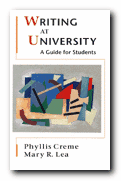 Writing at University: a guide for students is a popular UK guide to understanding questions, planning assignments, reading and note-taking, and developing arguments. It puts a lot of emphasis on the process which leads up to the act of writing, and tries to show you how to develop more confidence. Different types of writing are discussed, as well as the important skill of matching your writing to the conventions of the discipline you are studying. The approach is like that of a sympathetic counsellor.
Writing at University: a guide for students is a popular UK guide to understanding questions, planning assignments, reading and note-taking, and developing arguments. It puts a lot of emphasis on the process which leads up to the act of writing, and tries to show you how to develop more confidence. Different types of writing are discussed, as well as the important skill of matching your writing to the conventions of the discipline you are studying. The approach is like that of a sympathetic counsellor.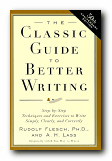 The Classic Guide to Better Writing is more-or-less what its title suggests. It’s a best-selling US guide with emphasis on how to generate, plan, and structure your ideas. It also covers basic grammar, good style, and common mistakes. The approach is step-by-step explanations on each topic, plenty of good advice on how to avoid common mistakes, and tips on how to gain a reader’s attention. Suitable for all types of writing, it well deserves its good reputation.
The Classic Guide to Better Writing is more-or-less what its title suggests. It’s a best-selling US guide with emphasis on how to generate, plan, and structure your ideas. It also covers basic grammar, good style, and common mistakes. The approach is step-by-step explanations on each topic, plenty of good advice on how to avoid common mistakes, and tips on how to gain a reader’s attention. Suitable for all types of writing, it well deserves its good reputation.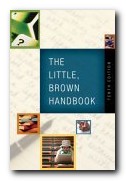 If you need just one book which will answer all your questions on writing – from punctuation to publication – then this is it. The Little, Brown Handbook is an encyclopaedic US guide to all aspects of writing. It includes vocabulary, punctuation, grammar, style, document design, MLA conventions, editing, bibliography, and the Internet. All topics are profusely illustrated and cross-indexed, and some of the longer entries are virtually short essays. It also has self-assessment exercises so that you can check that you have understood the contents of each chapter. The Swiss army penknife of writing guides. Highly recommended.
If you need just one book which will answer all your questions on writing – from punctuation to publication – then this is it. The Little, Brown Handbook is an encyclopaedic US guide to all aspects of writing. It includes vocabulary, punctuation, grammar, style, document design, MLA conventions, editing, bibliography, and the Internet. All topics are profusely illustrated and cross-indexed, and some of the longer entries are virtually short essays. It also has self-assessment exercises so that you can check that you have understood the contents of each chapter. The Swiss army penknife of writing guides. Highly recommended.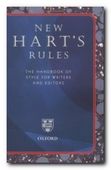 Hart’s Rules for Compositors and Readers at the University Press Oxford This is a UK classic guide to the finer points of editing and print preparation, spelling and typography. It was first written as the style guide for OUP, but quickly established a reputation well beyond. There’s no hand-holding here. Everything is pared to the bone. the centre of the book deals with ‘difficult’ and irregular spellings. A masterpiece of compression, it is now in its thirty-ninth edition. This is one for professionals rather than student writers.
Hart’s Rules for Compositors and Readers at the University Press Oxford This is a UK classic guide to the finer points of editing and print preparation, spelling and typography. It was first written as the style guide for OUP, but quickly established a reputation well beyond. There’s no hand-holding here. Everything is pared to the bone. the centre of the book deals with ‘difficult’ and irregular spellings. A masterpiece of compression, it is now in its thirty-ninth edition. This is one for professionals rather than student writers.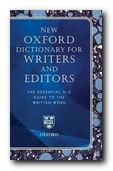 The Oxford Dictionary for Writers & Editors . This is a specialist dictionary for writers, journalists, and text-editors. Unlike most dictionaries, it does not offer explanations of the words meanings. It deals with problematic English and foreign words, offering correct spellings and consistent usage in the OUP house style. By concentrating on difficult cases, it saves you a lot of time. The latest edition also includes American spellings. Strongly recommended.
The Oxford Dictionary for Writers & Editors . This is a specialist dictionary for writers, journalists, and text-editors. Unlike most dictionaries, it does not offer explanations of the words meanings. It deals with problematic English and foreign words, offering correct spellings and consistent usage in the OUP house style. By concentrating on difficult cases, it saves you a lot of time. The latest edition also includes American spellings. Strongly recommended.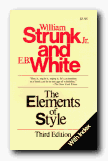 The Elements of Style. This is an old favourite – a ‘bare bones’ guidance manual which cuts out everything except the essential answers to the most common writing problems. It covers the elements of good usage, how to write clearly, commonly misued words and expressions, and advice on good style. The emergency first-aid kit of writing guides. It’s very popular, not least because it’s amazingly cheap. Suitable for beginners. There’s an online version available if you do a search – but the cost of a printed version will pay dividends.
The Elements of Style. This is an old favourite – a ‘bare bones’ guidance manual which cuts out everything except the essential answers to the most common writing problems. It covers the elements of good usage, how to write clearly, commonly misued words and expressions, and advice on good style. The emergency first-aid kit of writing guides. It’s very popular, not least because it’s amazingly cheap. Suitable for beginners. There’s an online version available if you do a search – but the cost of a printed version will pay dividends.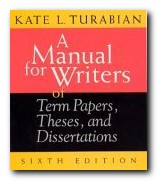 A Manual for Writers of Term Papers, Theses, and Dissertations. This is a modern American classic guidance manual for academic writing. It covers everything from abbreviations and numbers to referencing and page layout. It also includes sections showing how to lay out tables and statistics; lots on bibliographic referencing; and how to deal with public and government documents. The latest edition also includes advice on word-processing.
A Manual for Writers of Term Papers, Theses, and Dissertations. This is a modern American classic guidance manual for academic writing. It covers everything from abbreviations and numbers to referencing and page layout. It also includes sections showing how to lay out tables and statistics; lots on bibliographic referencing; and how to deal with public and government documents. The latest edition also includes advice on word-processing.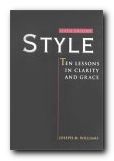 Style: Ten Lessons in Clarity and Grace. This is a popular guide – particularly amongst creative writing enthusiasts. It offers advice for improving your writing – by putting its emphasis on editing for clarity, creating structure, and keeping the audience in mind. These lessons are useful for all types of writing however. It has plenty of illustrative examples and exercises, an appendix with advice on punctuation, and a good glossary. Recommended.
Style: Ten Lessons in Clarity and Grace. This is a popular guide – particularly amongst creative writing enthusiasts. It offers advice for improving your writing – by putting its emphasis on editing for clarity, creating structure, and keeping the audience in mind. These lessons are useful for all types of writing however. It has plenty of illustrative examples and exercises, an appendix with advice on punctuation, and a good glossary. Recommended.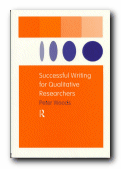 Successful Writing for Qualitative Researchers. This is one for specialist academic writing at post-graduate level. It covers all the stages of creating a scholarly piece of work – from the preparation of a project through to the completion and possible publication of the finished article. Includes sections on style, editing, and collaborative writing. It takes a positive and encouraging tone – which will be welcome to those embarking on such tasks for the first time.
Successful Writing for Qualitative Researchers. This is one for specialist academic writing at post-graduate level. It covers all the stages of creating a scholarly piece of work – from the preparation of a project through to the completion and possible publication of the finished article. Includes sections on style, editing, and collaborative writing. It takes a positive and encouraging tone – which will be welcome to those embarking on such tasks for the first time.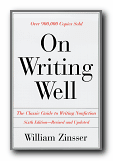 On Writing Well. This is a best-selling title, now in its sixth edition. It offers reassuring guidance from an experienced journalist on writing more effectively in a number of genres. He covers interviews, travel writing, memoirs, sport, humour, science and technology, and business writing. The approach is to take a passage and analyse it, showing how and why it works, or where it might be improved. It is particularly good on editing and re-writing.
On Writing Well. This is a best-selling title, now in its sixth edition. It offers reassuring guidance from an experienced journalist on writing more effectively in a number of genres. He covers interviews, travel writing, memoirs, sport, humour, science and technology, and business writing. The approach is to take a passage and analyse it, showing how and why it works, or where it might be improved. It is particularly good on editing and re-writing.